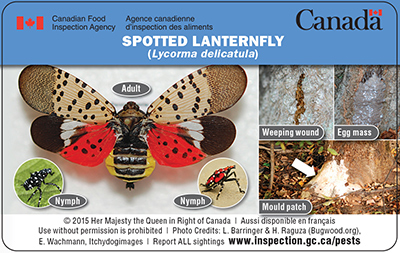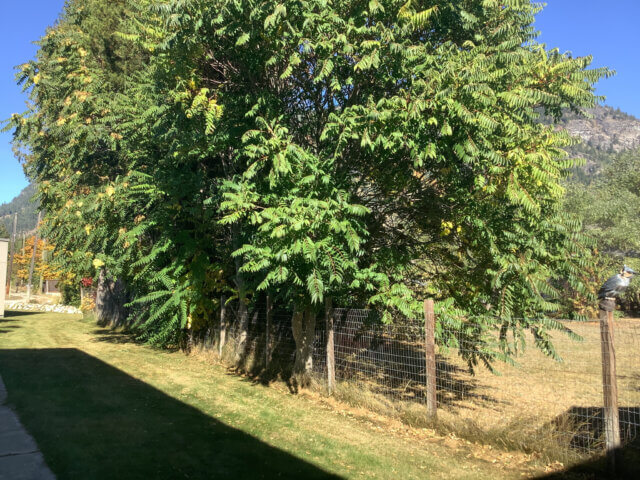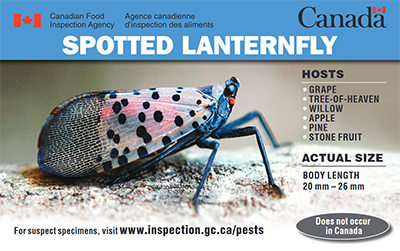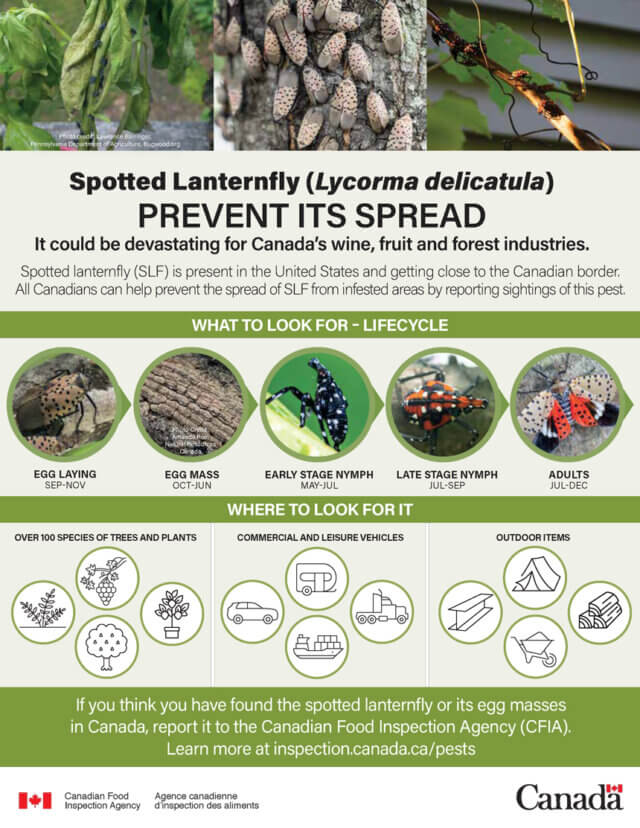What is black and white and red all over? Hint: it feeds on over 70 plant and tree species, especially fruit crops, is featured on late night comedy and is causing 45%-100% loss of grape crops in the mid-Atlantic states. Oh no! Save the wine! The answer is not a newspaper, but an agricultural pest the spotted lanternfly! The spotted lanternfly (Lycorma delicatula, Hemiptera: Fulgoridae) is an impressive and colourful insect native to Asia. It is not yet known to exist in Canada but is a potential threat to Canada’s grape, fruit tree and forestry industries. Spotted lanternfly was added to the regulated pest list in 2018 in an effort to prevent its introduction from infested areas.
Hosts
The spotted lanternfly feeds on various host plants throughout its development. Nymphs feed on a wide range of plant species, while adults prefer to feed and lay eggs on tree-of-heaven (Ailanthus altissima), also known as the Chinese or stinking sumac. Other hosts include grape (Vitis), apples (Malus), plums (Prunus domestica), cherries (P. avium), peaches and nectarines (P. persica), apricots (P. armeniaca), and pine (Pinus). It also feeds on oak (Quercus), walnut (Juglans), and poplar (Populus).

Why is the spotted lanternfly important to the Kootenays?
The spotted lanternfly could have devastating impacts on the agricultural economy and stress our native and garden trees. To date, the preferred host of the spotted lanternfly, the tree of heaven has been found in the CKISS region at 20 sites. To learn more about the tree of heaven click here. By eliminating the tree of heaven in Canada, the risk of the spotted lanternfly spreading in Canada will be significantly reduced. To this, end efforts at finding a biocontrol agent to control and reduce the presence of tree of heaven are underway.
What you can do about it
- Do not plant tree-of-heaven.
- Ensure vehicles and machinery are free of soil and plant parts prior to movement.
- Consider removing tree-of-heaven from your property to limit the spread and impacts of spotted lanternfly.
- Look for tree-of-heaven in cities, agricultural fields, forests, forest margins, along roadsides, riverbanks, and rail corridors, and in other disturbed areas. Report tree of heaven sightings to CKISS. To identify tree of heaven click here.
- It’s important not to accidentally transport spotted lanternfly into Canada, so if you’re travelling or going camping in infested areas of the US, check your camper, trailer or RV before making the return trip
- Inspect things stored outside, including your vehicle and patio furniture
- Spotted lanternfly egg masses are laid in late summer
- These egg masses can survive winter temperatures and hatch in the spring
- If you think you have found the spotted lanternfly pest or egg masses in Canada, scrape them into a sealable container and immediately notify the Canadian Food Inspection Agency (CFIA)
- If you think you have found a plant pest, report it to the CFIA.


